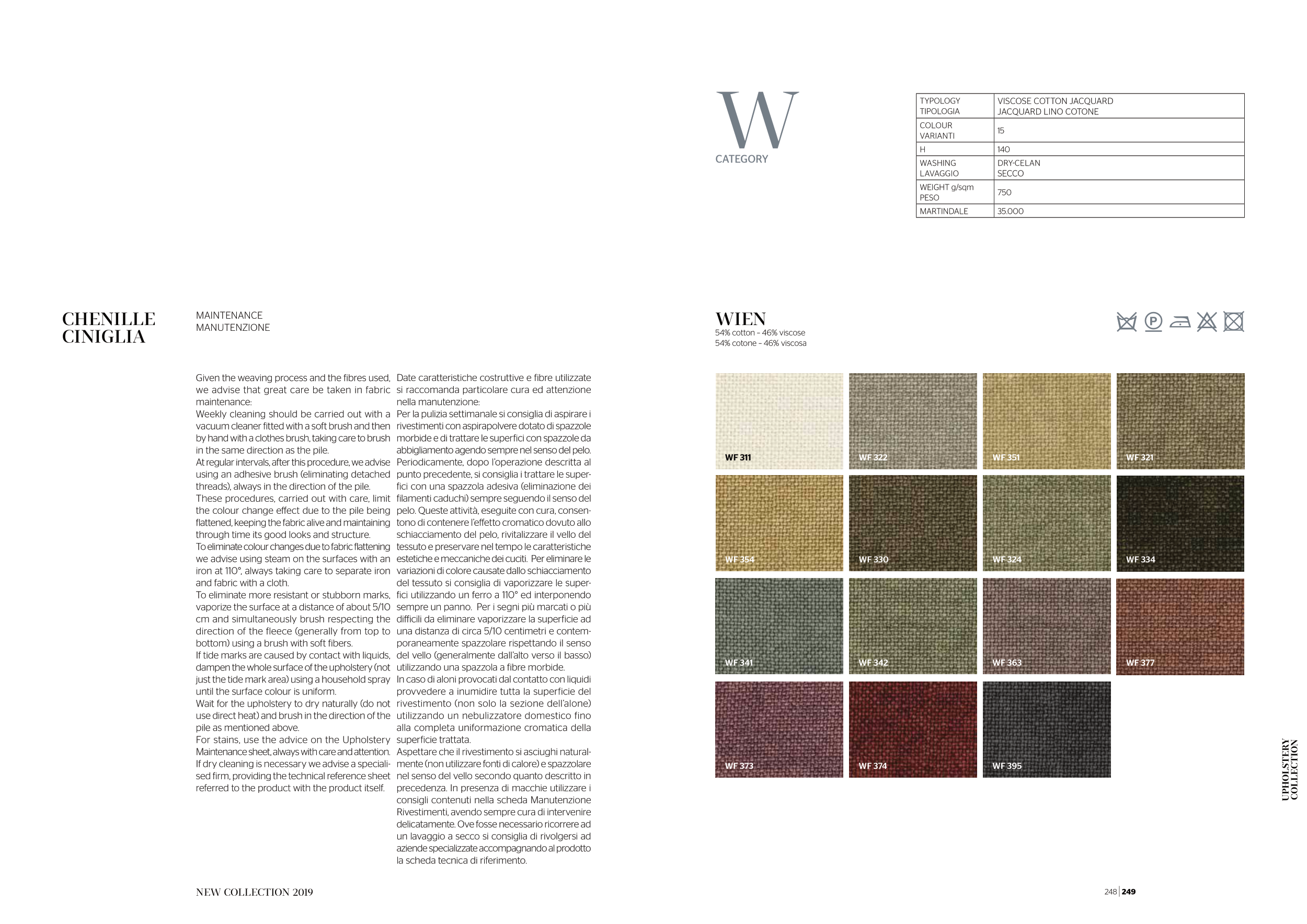248 249
NEW COLLECTION 2019
Given the weaving process and the fibres used,
we advise that great care be taken in fabric
maintenance:
Weekly cleaning should be carried out with a
vacuum cleaner fitted with a soft brush and then
by hand with a clothes brush, taking care to brush
in the same direction as the pile.
At regular intervals, after this procedure, we advise
using an adhesive brush (eliminating detached
threads), always in the direction of the pile.
These procedures, carried out with care, limit
the colour change effect due to the pile being
flattened, keeping the fabric alive and maintaining
through time its good looks and structure.
To eliminate colour changes due to fabric flattening
we advise using steam on the surfaces with an
iron at 110°, always taking care to separate iron
and fabric with a cloth.
To eliminate more resistant or stubborn marks,
vaporize the surface at a distance of about 5/10
cm and simultaneously brush respecting the
direction of the fleece (generally from top to
bottom) using a brush with soft fibers.
If tide marks are caused by contact with liquids,
dampen the whole surface of the upholstery (not
just the tide mark area) using a household spray
until the surface colour is uniform.
Wait for the upholstery to dry naturally (do not
use direct heat) and brush in the direction of the
pile as mentioned above.
For stains, use the advice on the Upholstery
Maintenance sheet, always with care and attention.
If dry cleaning is necessary we advise a speciali-
sed firm, providing the technical reference sheet
referred to the product with the product itself.
Date caratteristiche costruttive e fibre utilizzate
si raccomanda particolare cura ed attenzione
nella manutenzione:
Per la pulizia settimanale si consiglia di aspirare i
rivestimenti con aspirapolvere dotato di spazzole
morbide e di trattare le superfici con spazzole da
abbigliamento agendo sempre nel senso del pelo.
Periodicamente, dopo l’operazione descritta al
punto precedente, si consiglia i trattare le super-
fici con una spazzola adesiva (eliminazione dei
filamenti caduchi) sempre seguendo il senso del
pelo. Queste attività, eseguite con cura, consen-
tono di contenere l’effetto cromatico dovuto allo
schiacciamento del pelo, rivitalizzare il vello del
tessuto e preservare nel tempo le caratteristiche
estetiche e meccaniche dei cuciti. Per eliminare le
variazioni di colore causate dallo schiacciamento
del tessuto si consiglia di vaporizzare le super-
fici utilizzando un ferro a 110° ed interponendo
sempre un panno. Per i segni più marcati o più
difficili da eliminare vaporizzare la superficie ad
una distanza di circa 5/10 centimetri e contem-
poraneamente spazzolare rispettando il senso
del vello (generalmente dall’alto verso il basso)
utilizzando una spazzola a fibre morbide.
In caso di aloni provocati dal contatto con liquidi
provvedere a inumidire tutta la superficie del
rivestimento (non solo la sezione dell’alone)
utilizzando un nebulizzatore domestico fino
alla completa uniformazione cromatica della
superficie trattata.
Aspettare che il rivestimento si asciughi natural-
mente (non utilizzare fonti di calore) e spazzolare
nel senso del vello secondo quanto descritto in
precedenza. In presenza di macchie utilizzare i
consigli contenuti nella scheda Manutenzione
Rivestimenti, avendo sempre cura di intervenire
delicatamente. Ove fosse necessario ricorrere ad
un lavaggio a secco si consiglia di rivolgersi ad
aziende specializzate accompagnando al prodotto
la scheda tecnica di riferimento.
MAINTENANCE
MANUTENZIONE
CHENILLE
CINIGLIA
WIEN
54% cotton – 46% viscose
54% cotone – 46% viscosa
TYPOLOGY
TIPOLOGIA
VISCOSE COTTON JACQUARD
JACQUARD LINO COTONE
COLOUR
VARIANTI
15
H
140
WASHING
LAVAGGIO
DRY-CELAN
SECCO
WEIGHT g/sqm
PESO
750
MARTINDALE
35.000
CATEGORYW
WF 311
WF 354
WF 341
WF 373
WF 322
WF 330
WF 342
WF 374
WF 351
WF 324
WF 363
WF 395
WF 321
WF 334
WF 377
UPHOLSTERY
COLLECTION


